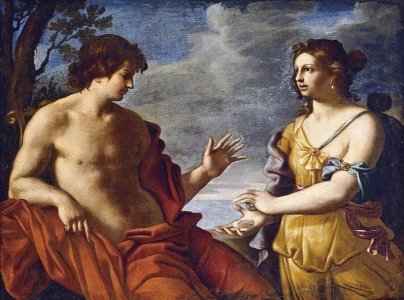Cumaean Sybil 2
What is claimed to be the most significant legend of the Cumaean Sibyl is illustrated below. She visited the last king of Rome, Tarquin the proud, with nine books containing predictions about the future of Rome. Tarquin thought that the asking price was far too high. She went away and burnt three of the books, then returned. The price for six books was the same as the price asked for nine, and the sibyl was sent away once more. She burnt three more, then returned to Tarquin demanding the same amount. At this point, Tarquin consulted his augers and realised he had made a huge mistake; he agreed to the asking price. The three books remained as precious items, consulted by the rules of Rome: it is claimed (by some) that fragments of some of the pages of the 'Sibylline books' remain to this day.

Nicolaes van Helt Stockade: King Tarquin and the Cumaean Sibyl, c 1650
By far the best known image of the Cumaean Sybil is this one by Michelangelo, on the Sistine Chapel ceiling. Unlike the other portraits we have seen, here she is elderly and unattractive.


So why is she portrayed in this way? To answer this, we need to consider her relationship with the god Apollo. This picture reveals all.

Giovani Domenico Cerrini: Apollo and the Cumaean Sibyl
Back to page 1 Home page - explore the site